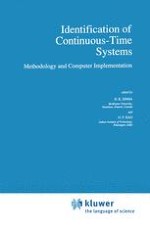In view of the importance of system identification, the International Federation of Automatic Control (IFAC) and the International Federation of Operational Research Societies (IFORS) hold symposia on this topic every three years. Interest in continuous time approaches to system identification has been growing in recent years. This is evident from the fact that the of invited sessions on continuous time systems has increased from one in the 8th number Symposium that was held in Beijing in 1988 to three in the 9th Symposium in Budapest in 1991. It was during the 8th Symposium in August 1988 that the idea of bringing together important results on the topic of Identification of continuous time systems was conceived. Several distinguished colleagues, who were with us in Beijing at that time, encouraged us by promising on the spot to contribute to a comprehensive volume of collective work. Subsequently, we contacted colleagues all over the world, known for their work in this area, with a formal request to contribute to the proposed volume. The response was prompt and overwhelmingly encouraging. We sincerely thank all the authors for their valuable contributions covering various aspects of identification of continuous time systems.
